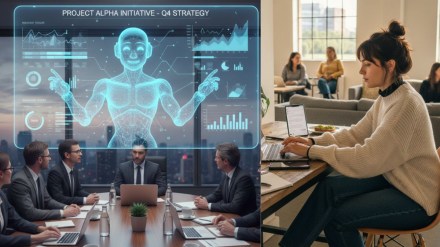Vibe working is the latest evolution in white-collar work, one where structure gives way to spontaneity, and humans collaborate with AI in a more fluid, iterative way.
Unlike traditional workflows or rigid corporate hierarchies, vibe working allows ideas to emerge through back-and-forth interaction between people and generative tools.
At its core, it is about using AI to turn fuzzy thoughts into structured outputs through iteration.
Rather than aiming for perfection at the start, workers describe a goal in plain language and then refine it with the help of AI, producing code, strategies, documents, or designs through a creative feedback loop.
What is vibe working?
The term first gained traction in tech circles through “vibe coding,” where generative AI began reshaping software development.
Big Tech leaders jumped on board: Sundar Pichai has been vibe coding web pages, Mark Zuckerberg says AI is replacing mid-level engineers, and Klarna’s CEO Sebastian Siemiatkowski claims AI turned him into an amateur coder.
Now the trend is spreading beyond engineering. Microsoft rolled out “vibe working” tools in Word and Excel, letting people “vibe write” documents or “speak Excel” without expert knowledge.
Startups are hiring for roles like “Vibe Growth Manager,” tasked with fast-paced AI experiments. Apps like Mea and Sora are even giving rise to “vibe creators” using AI-generated video.
But with the rise of vibe working comes a certain ambiguity. “Everyone might have a different interpretation of what the vibe is,” says Ben Armstrong, executive director of MIT’s Industrial Performance Center to Business Insider.
What started as a casual shorthand is now being used in job titles and management frameworks, with companies holding “vibe checks” and even experimenting with “Chief Vibe Officer” roles.
But as Armstrong warns, “One person’s good vibe could be the other person’s bad vibe.”
Impact of vibe working
Vibe working still requires skill and effort. Emily DeJeu, professor at Carnegie Mellon University’s Tepper School of Business, compares it to jazz: the improvisation works only because of years of technical training. “Labour is labour, and the labour to build expertise is laborious,” she told Business Insider.
While vibe working can make creativity feel easy, she warns against romanticising the process: “The idea that you can vibe and ‘you don’t have to spend all that time, and it’s not hard’ is kind of laughable, in my opinion,” Dejeu told Business Insider.
AI might help speed things up, but it also shifts responsibility. Developers are now spending more time reviewing AI-generated code for bugs. Marketers use AI to process data but still need to lead with strategy.
“As you have an idea, you should also have your strategy and your objectives, and then you should use AI to help you flush out the idea,” says Emilie DiFranco, vice president of marketing at Marketri to Business Insider. Without those foundations, AI can just produce “workslop” piles of neat-looking but useless content.
Meanwhile, the pressure on workers is rising. Most companies are not training employees to use AI effectively, even though 71% of business leaders would hire a less experienced applicant with AI skills over one with more experience but no AI knowledge.
The result is a top-down expectation with bottom-up learning, leaving workers to figure things out on their own. We are in a moment like the early days of the internet, where experimentation rules and consistent outcomes are hard to define. “Because a vibe is so open to interpretation,” he says to Business Insider, “it’s so hard to measure what the outcome of these different tasks might be.”
In the end, the vibe may be in, but the work behind it is real.
